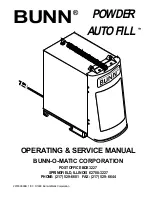
13
How the unit works
Heating
Heating of both the mold and the crucible is achieved in separate heaters, using a
state-of-the art alloy heating elements coiled around rigid ceramic rods. These
rods run along a semi-soft, highly insulating material. These parts are then
assembled into an aluminum container.
During heating, temperature is controlled by means of a platinum thermocouple.
To improve energy efficiency, a small cover is moved over the crucible. This lid
also doubles as a stopper that keeps the crucible in its heater during pouring.
In the case of the mold, a ring-shaped holder is placed around the mold to keep
as much energy in the heater as possible.
Agitation and
pouring of the
melt
Homogenization of the sample into the flux is produced by the rotation of a
geared stepper motor located at the far right of the instrument. This motor
directly drives the crucible heater with a back-and-forth motion to agitate the
melt.
At the moment of pouring, this tilting motor rotates the crucible heater further
forward to an adjustable pouring angle, at an adjustable speed. The melt pours
naturally into the mold, and the crucible heater is automatically brought back to
the horizontal, ready for another fusion.
The pouring step can also be completely disabled, for procedures such as
pyrosulfate or peroxide fusions, which do not need transferring the melt into
another container.
Cooling
The mold heater is fastened right above a blower (centrifugal fan). When
requested, this fan is powered and draws fresh air through the holes of the
ceramic ring around the mold, then through the holes at the bottom of the mold
heater ceramic shell. The mold heater thermocouple monitors the cooling process.
Solution
agitation
Making solutions requires that the instrument be fitted with the optional solution
agitation module.
When making solutions, the hot melt is poured directly into a beaker containing
an acid. This beaker, along with the solution agitation module, is to be installed
before the fusion is launched. The acid solution must be agitated to improve the
dissolution speed of the crystallized flux and sample.
Summary of Contents for K1 PRIME
Page 1: ...Automatic fluxer 1...
Page 2: ......
















































